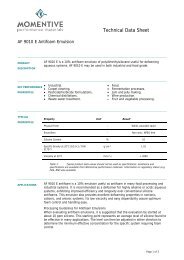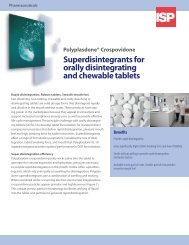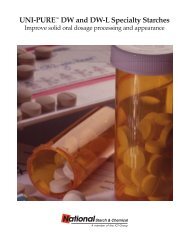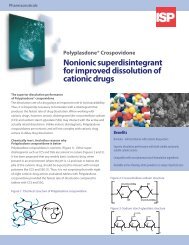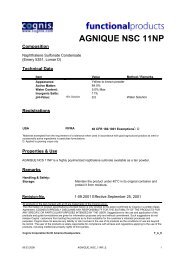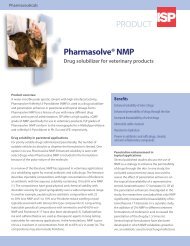Inert Lubricants Oils – Greases – Waxes - Anshul Life Sciences
Inert Lubricants Oils – Greases – Waxes - Anshul Life Sciences
Inert Lubricants Oils – Greases – Waxes - Anshul Life Sciences
You also want an ePaper? Increase the reach of your titles
YUMPU automatically turns print PDFs into web optimized ePapers that Google loves.
<strong>Inert</strong> <strong>Lubricants</strong><br />
<strong>Oils</strong> <strong>–</strong> <strong>Greases</strong> <strong>–</strong> <strong>Waxes</strong>
Halocarbon <strong>Inert</strong> <strong>Lubricants</strong><br />
Halocarbon oils, greases and waxes are polychlorotrifluoroethylenes (PCTFE), which are<br />
chemically inert and nonflammable lubricants with high thermal stability, good lubricity,<br />
high dielectric strength and low compressibility. Halocarbon was the first to commercially<br />
produce PCTFE-based lubricants over 60 years ago.<br />
We offer a wide range of oils, greases and waxes to meet industries' needs. The inertness<br />
of our lubricant is required for the safe handling of highly reactive and/or aggressive<br />
chemicals like oxygen, chlorine, hydrogen peroxide, sulfur trioxide and nitric acid. This<br />
unique chemistry can also provide advantage in many other applications from lab-scale<br />
to the production plant.<br />
Have questions? Contact Shaun Julian. E-mail: sjulian@halocarbon.com<br />
Contents<br />
Chemical Composition 3<br />
Chemical <strong>Inert</strong>ness 3<br />
Oxidizer <strong>Inert</strong>ness Tests 5<br />
Oxygen <strong>Inert</strong>ness Tests, Table 1 5<br />
Shock Sensitivity, Table 2 5<br />
Physical Properties 6<br />
<strong>Oils</strong>, Table 3 7<br />
<strong>Waxes</strong>, Table 4 7<br />
<strong>Greases</strong>, Table 5 8<br />
Vapor Pressures, Figure 1 9<br />
Viscosity vs. Temperature, Figure 2 10<br />
Solubilities 6, 11<br />
Bulk Modulus 11<br />
Lubricity 11<br />
Thermal Properties 11<br />
Surface Tension 12<br />
Electrical Properties 12<br />
Thermal Stability 12<br />
Material Compatibility 12<br />
Elastomers and Plastics 12<br />
Metals 13<br />
Selecting a Halocarbon Oil Grade 14<br />
Industrial Lubricant<br />
Viscosity Ratings, Table 6 14<br />
Blending to a Custom Viscosity 15<br />
Oil Blending Chart, Figure 3 15<br />
Quality Assurance 16<br />
Toxicity 16<br />
Export Shipments 17<br />
Typical Applications 17<br />
2
Chemical Composition<br />
Halocarbon oils are saturated, hydrogen-free low molecular weight polymers of<br />
chlorotrifluoroethylene having the formula <strong>–</strong>(CF2CFCl)n<strong>–</strong>, where n ranges from 2 to<br />
approximately 10. They are made by controlled polymerization and then stabilized.<br />
Halocarbon greases are made by incorporating gelling agents into Halocarbon oils to form<br />
two classes of grease. In one class, the thickening agent is an inert polymer, either PCTFE<br />
or PTFE. Therefore, the chemical properties of these greases are identical to the oils. The<br />
other class of grease is made from oils thickened with silica. Therefore, these greases have<br />
the chemical properties of silica (see Chemical <strong>Inert</strong>ness, below).<br />
Both the oils and greases can be supplied with a conventional hydrocarbon rust inhibitor<br />
added to give extra protection to steel in high humidity and other corrosive environments.<br />
The presence of the inhibitor does not compromise the inertness of Halocarbon lubricants<br />
to oxygen (see Oxidizer <strong>Inert</strong>ness Tests, p. 5).<br />
For applications where extra wear is anticipated, an anti-wear agent can be added to any<br />
oil grade. This agent does not compromise the inertness of the oils.<br />
Chemical <strong>Inert</strong>ness<br />
The most outstanding property of Halocarbon oils, greases and waxes is their chemical<br />
inertness. This property, together with their nonflammability, long life, good lubricity and high<br />
dielectric strength, makes Halocarbon oils a safe and economically justifiable purchase for a<br />
wide number of applications. In addition, Halocarbon oils have no flash or fire points and are<br />
low in toxicity. They are among the safest lubricants you can buy.<br />
Halocarbon oils and waxes are inert toward practically all compounds and solutions. This<br />
also applies to Halocarbon greases with the exception that the silica-thickened greases are<br />
prone to attack by chemicals active toward silica. Silica is attacked by alkalis, hydrofluoric<br />
acid and fluorinating agents so the silica-thickened greases should not be used in those<br />
applications (unless testing indicates otherwise).<br />
back to Contents 3
Halocarbon lubricants are compatible with the following chemicals and many others not as<br />
widely used:<br />
Aluminum chloride<br />
Ammonium nitrate<br />
Ammonium perchlorate<br />
Antimony trichloride<br />
Boron trichloride<br />
Boron trifluoride<br />
Bromine<br />
Bromine trifluoride (gaseous)<br />
Calcium hypochlorite<br />
Carbon dioxide<br />
Chlorinated cyanurates<br />
Chlorine<br />
Chlorine dioxide<br />
Chlorosilanes<br />
Chlorosulfonic acid<br />
Chromic acid<br />
Chromyl nitrate<br />
Ethylene oxide<br />
Fluorine (gaseous)<br />
Fuming nitric acid<br />
Hydrogen<br />
Hydrogen bromide<br />
Hydrogen fluoride<br />
Hydrogen peroxide (all<br />
concentrations)<br />
Hydrogen sulfide<br />
Hydroiodic acid<br />
Iodine<br />
Muriatic acid<br />
Nitrogen oxides (all)<br />
Nitrogen trifluoride<br />
Oleum<br />
Oxygen (liquid and gaseous)<br />
Ozone<br />
Phosphoric acid<br />
Phosphorus oxychloride<br />
Potassium perchlorate<br />
Potassium persulfate<br />
Propylene oxide<br />
Silane<br />
Silicon tetrachloride<br />
Sodium chlorate<br />
Sodium hydroxide (all<br />
concentrations)<br />
Sodium hypochlorite<br />
Sodium perchlorate<br />
Sulfur dioxide<br />
Sulfur hexafluoride<br />
Sulfur trioxide<br />
Sulfuric acid<br />
Thionyl chloride<br />
Titanium tetrachloride<br />
Uranium hexafluoride<br />
Caution: Halocarbon lubricants should not be used in contact with sodium or potassium<br />
metal, amines, including amine additives (antioxidants, etc.), liquid fluorine or liquid bromine<br />
trifluoride. Caution should be used with aluminum and magnesium (and alloys of these<br />
metals) under conditions of large shear forces such as those found in threaded connections.<br />
See page 13 (Metals) for further details.<br />
Halocarbon oils, greases and waxes also will not contribute fuel in fire-prone applications.<br />
For example, silane, a pyrophoric gas used by the semiconductor industry, would ignite<br />
hydrocarbon vacuum pump oils when the silane itself ignites. Therefore, a silane fire could<br />
be much less serious if Halocarbon oils were used instead of hydrocarbon oils.<br />
back to Contents<br />
4
Oxidizer <strong>Inert</strong>ness Tests<br />
Because of industry’s ever expanding use of strong oxidizing agents, many test procedures<br />
have been developed to determine the safety of lubricants in contact with these agents.<br />
The results of one method, ASTM G72 “Standard Test Method for Autogenous Ignition<br />
Temperature of Liquids and Solids in a High-Pressure Oxygen-Enriched Environment,” are<br />
given for several Halocarbon oils and greases in Table 1 (below). None of Halocarbon’s<br />
lubricants, including those with rust inhibitor, ignite throughout the entire testing range,<br />
exceeding 400°C (752°F) and 2,000 psig (13.9 MPa).<br />
Also in Table 1 are the results of a test similar to ASTM D2512 “Test for Compatibility of<br />
Materials with Liquid Oxygen (Impact Sensitivity Threshold Technique).” The apparatus<br />
used has upper limits in excess of the ASTM method. Again, none of Halocarbon’s products<br />
showed any sensitivity at the highest impact loading.<br />
Table 2 (below) shows how insensitive Halocarbon oils are to shock in the presence of 90%<br />
hydrogen peroxide and liquid oxygen. No sensitivity was detected with any treatment.<br />
Halocarbon lubricants have also been evaluated by the German Federal Institute for Materials<br />
Research and Testing (BAM) for lack of reactivity with gaseous oxygen under pressure.<br />
Table 1. Oxygen <strong>Inert</strong>ness Tests<br />
Autogenous<br />
Ignition Temp. 1<br />
(°C)<br />
Impact<br />
Sensitivity 2<br />
(foot-pounds)<br />
Halocarbon 4.2 >400 (752°F) 3 >114 3<br />
<strong>Oils</strong> 4.25 >400 >114<br />
56 >400 >114<br />
56S >400 >114<br />
700 >400 >114<br />
700S >400 >114<br />
HaloVac ® 100 >400 >114<br />
<strong>Oils</strong> 4 190 >400 >114<br />
Halocarbon 25-5S >400 >114<br />
<strong>Greases</strong> 25-5SI >400 >114<br />
25-10M >400 >114<br />
25-10MS >400 >114<br />
1. ASTM G72 "Standard Test Method for Autogenous Ignition Temperature of<br />
Liquids and Solids in a High-Pressure Oxygen-Enriched Environment".<br />
Table 2. Shock Sensitivity 1<br />
Oxidizer<br />
H 2<br />
0 2<br />
(90%) H 2<br />
0 2<br />
(90%) LOX<br />
Oxidizer/Oil<br />
8/1 None None —<br />
4/1 None None —<br />
2/1 None None —<br />
1/1 — — None<br />
Pretreatment<br />
Temp. 2 °F 160 70 -300<br />
°C 71.1 21 -184<br />
Test<br />
Temp. °F 70 70 -300<br />
°C 21 21 -184<br />
1. Tests run on a Picatinny Arsenal type impact tester (see Picatinny Technical<br />
Report 1401, Revision 1, 1950).<br />
2. Mixtures of Halocarbon oil and 90% H 2<br />
0 2<br />
held at constant temperature for 24<br />
hours prior to test.<br />
2. Similar to ASTM D2512 "Test for Compatibility of Materials with LIquid Oxygen<br />
(Impact Sensitivity Threshold Technique)". See Text.<br />
3. Upper limit of text.<br />
4. See Vacuum Pump Fluids, p. 22.<br />
back to Contents<br />
5
Physical Properties<br />
As the viscosity of the Halocarbon oils increase, so does the density, pour point and cloud<br />
point. Table 3 (p. 7) lists these and other physical properties. The vapor pressure is inversely<br />
related to viscosity of the oil, as shown in Figure 1 (p. 9). The viscosity of an oil decreases<br />
with temperature as shown in Figure 2 (p. 10). These data will help choose the appropriate<br />
oil for a particular application.<br />
The polymers change from oils to waxes as the viscosity increases. The waxes are all white<br />
solids at room temperature that melt upon heating. They have initial boiling points above<br />
260°C (500°F) and densities of about 1.89 g/mL at 99°C (210°F). Drop melting point and<br />
viscosity data are given in Table 4 (p. 7).<br />
The properties of Halocarbon greases depend upon how heavily they are gelled. Table 5 (p. 8)<br />
gives penetration, service temperature range and drop melting point data.<br />
Solubility of Halocarbon Fluids in Other Solvents<br />
The lower viscosity Halocarbon oils are soluble in most organic liquids but solubility<br />
decreases as viscosity increases. All Halocarbon fluids are insoluble in aqueous solutions<br />
however stable emulsions are possible with fluorinated surfactants.<br />
Solubility of Other Substances in Halocarbon Fluids<br />
Halocarbon fluids will dissolve halogens and volatile anhydrous inorganic salts (such as<br />
titanium tetrachloride). Typical organic materials with which various Halocarbon oils are<br />
miscible are:<br />
Acetone<br />
Amyl acetate<br />
Benzene<br />
n-Butyl alcohol<br />
Carbon disulfide<br />
Dioctyl phthalate<br />
Dioctyl sebacate<br />
Ethanol<br />
Ether<br />
Glacial acetic acid<br />
Hexane<br />
Isopropyl alcohol<br />
Kerosene<br />
Methanol<br />
Methyl ethyl ketone<br />
Methyl isobutyl ketone<br />
Methylene chloride<br />
Mineral oils<br />
Silicone oils<br />
Tetrachloroethylene<br />
Trichloroethylene<br />
back to Contents<br />
6
Table 3. Halocarbon <strong>Oils</strong> 1<br />
Oil 0.8 1.8 4.2 6.3 27 56 95 200 400 700 1000N<br />
Flash and Fire Points<br />
None<br />
Pour Point 2 °F (±10°F) -200 -135 -100 -95 -40 -30 -15 10 15 40 50<br />
°C (±5°C) -129 -93 -73 -71 -40 -34 -26 -12 -9 5 10<br />
Cloud Point 3 °F (±10°F)
Table 5. Halocarbon <strong>Greases</strong><br />
Consistency<br />
ASTM Service Minimum Drop<br />
Grease NLGI Penetration Temperature Melting Point Description<br />
PCTFE/Silica Thickened <strong>Greases</strong><br />
28I 2 265-295 0 to 250°F<br />
-20 to 120°C<br />
None<br />
This product contains a<br />
rust inhibitor.<br />
28LTI 2 265-295 -50 to 200°F<br />
-45 to 95°C<br />
None<br />
For low temperature use.<br />
This product contains a<br />
rust inhibitor.<br />
25-5S 3 220-250 0 to 350°F<br />
-20 to 175°C<br />
None<br />
Lowest vapor pressure.<br />
Also available with rust<br />
inhibitor (25-5SI), which<br />
has a recommended<br />
service temperature of<br />
0 to 250°F (-20 to 120°C).<br />
PCTFE/PTFE Thickened Grease<br />
MT-3l 3 220-250 0 to 350°F<br />
-20 to 175°C<br />
None<br />
Ideal as a thread sealant<br />
to prevent galling. This<br />
product contains a rust<br />
inhibitor.<br />
PCTFE/PCTFE Polymer Thickened <strong>Greases</strong> *<br />
25-10M 1 310-340 30 to 275°F<br />
0 to 135°C<br />
300°F<br />
150°C<br />
Softest grease for wide<br />
temperature range. Also<br />
available with a rust<br />
inhibitor (25-10MS).<br />
X90-10M 1 310-340 -40 to 200°F<br />
-40 to 95°C<br />
300°F<br />
150°C<br />
For low temperature use.<br />
25-20M 4 175-205 20 to 300°F<br />
-5 to 150°C<br />
320°F<br />
160°C<br />
Hardest grease with broad<br />
temperature range.<br />
* This table gives typical properties (not specifications) based on historical production performance. Halocarbon Products Corporation does not make<br />
any express or implied warranty that these products will continue to have these typical properties.<br />
back to Contents<br />
8
27<br />
Figure 1. Typical Vapor Pressures for Halocarbon <strong>Oils</strong><br />
1000<br />
Temperature (°C)<br />
-10 0 10 20 30 40 50 60 70 80 90 100 120 140 160 180 200 220 240<br />
1000<br />
500<br />
400<br />
300<br />
200<br />
100<br />
50<br />
40<br />
30<br />
20<br />
500<br />
400<br />
300<br />
200<br />
100<br />
50<br />
40<br />
30<br />
20<br />
10<br />
10<br />
Vapor pressure (millimeters of mercury)<br />
5<br />
4<br />
3<br />
2<br />
1<br />
0.5<br />
0.4<br />
0.3<br />
0.2<br />
0.1<br />
0.8<br />
1.8<br />
5<br />
4<br />
3<br />
2<br />
1<br />
0.5<br />
0.4<br />
0.3<br />
0.2<br />
0.1<br />
Vapor pressure (millimeters of mercury)<br />
0.05<br />
0.04<br />
0.03<br />
4.2<br />
6.3<br />
0.05<br />
0.04<br />
0.03<br />
0.02<br />
0.02<br />
0.01<br />
0.01<br />
0.005<br />
0.004<br />
0.003<br />
56<br />
0.005<br />
0.004<br />
0.003<br />
0.002<br />
95<br />
200<br />
400<br />
700<br />
1000N<br />
0.002<br />
0.001<br />
0.001<br />
0 20 40 60 80 100 120 140 160 180 200 220 240 280 320 360 400 450 500<br />
Temperature (°F)<br />
1 mm Hg (@0°C) = 1torr = 133.32 Pa = 1.33mbar<br />
back to Contents<br />
9
Figure 2. Viscosity vs. Temperature of Halocarbon <strong>Oils</strong><br />
Modified ASTM D341<br />
Kinematic viscosity (centistokes)<br />
10000<br />
5000<br />
3000<br />
2000<br />
1000<br />
500<br />
400<br />
300<br />
200<br />
100<br />
80<br />
60<br />
50<br />
40<br />
30<br />
20<br />
10<br />
9.0<br />
8.0<br />
7.0<br />
6.0<br />
5.0<br />
4.0<br />
3.0<br />
2.0<br />
1.80<br />
1.60<br />
1.40<br />
1.20<br />
1.00<br />
0.90<br />
0.80<br />
Temperature (°C)<br />
-70 -60 -50 -40 -30 -20 -10 0 10 20 30 40 50 60 70 80 90 100 110 120 130 140 150 160 170 180 190 200<br />
-100 -90 -80 -70 -60 -50 -40 -30 -20 -10 0 10 20 30 40 50 60 70 80 90 100 110 120 130 140 150 160 170 180 200 220 240 260 280 300 320 340 360 380 400<br />
Temperature (°F)<br />
10000<br />
5000<br />
3000<br />
2000<br />
1000<br />
500<br />
400<br />
300<br />
200<br />
100<br />
80<br />
60<br />
50<br />
40<br />
30<br />
20<br />
10<br />
9.0<br />
8.0<br />
7.0<br />
6.0<br />
5.0<br />
4.0<br />
3.0<br />
2.0<br />
1.80<br />
1.60<br />
1.40<br />
1.20<br />
1.00<br />
0.90<br />
0.80<br />
1000N<br />
700<br />
400<br />
200<br />
95<br />
56<br />
27<br />
6.3<br />
4.2<br />
1.8<br />
0.8<br />
Kinematic viscosity (centistokes)<br />
back to Contents<br />
10
Solubility of Gases in Halocarbon Fluids<br />
Halocarbon fluids dissolve gases readily. Chlorine, for example, is soluble to the extent of<br />
several weight percent at ambient conditions. Oxygen, nitrogen and carbon dioxide dissolve<br />
to the extent of 0.15, 0.26 and 1.3 mL of gas per mL of Halocarbon 27 oil at 25°C (77°F) and<br />
atmospheric pressure, respectively. Gas solubility increases with an increase in pressure.<br />
Halocarbon 27 oil dissolves 10.2 mL of nitrogen gas per mL of oil at 1,000 psig (7.0 MPa)<br />
and 37.8°C (100°F) but Halocarbon 6.3 oil dissolves only 5.4 mL of gas per mL of oil under<br />
the same conditions.<br />
Oil viscosity and density are reduced appreciably by dissolved gas.<br />
Bulk Modulus<br />
Bulk modulus measurements for Halocarbon oils are well over 200,000 psi (1,379 MPa)<br />
at 37.8°C (100°F) with applied pressures up to 10,000 psig (69.1 MPa). Halocarbon<br />
oils have compressibilities similar to mineral oils and are much less compressible than<br />
perfluoropolyethers.<br />
Lubricity<br />
Halocarbon oils can be used interchangeably with hydrocarbon oils to lubricate a wide range<br />
of equipment such as bearings, compressors, gear boxes and oil pumps. Occasionally, some<br />
equipment modification may be required because of density, viscosity or vapor pressure<br />
differences from hydrocarbon lubricants.<br />
Extreme-pressure tests using the four-ball method show that Halocarbon oils and greases<br />
are very good lubricants. The oils exhibit no seizure even at a final applied load of 800 Kg.<br />
These greases and oils have load wear indexes that are appreciably better that hydrocarbon<br />
oils. Scar diameters increasing uniformly with increasing applied load.<br />
Halocarbon oils have been used successfully in all types of equipment for over 50 years.<br />
However, if there is any question of suitability or interchangeability, a monitored test in the<br />
equipment is advised.<br />
Thermal Properties<br />
Heats of vaporization of Halocarbon oils vary from 36 to 54 BTU/lb (84 to 126 KJ/Kg). Their<br />
specific heats range from 0.2 to 0.25 BTU/(lb)(°F) [837 to 1,047 J/(Kg)(°C)] as the molecular<br />
weight increases. Thermal conductivities also increase with molecular weight, but they are<br />
all close to 0.1 BTU/(hr)(ft2)(°F/ft) [0.17 W/(°K)(m)].<br />
back to Contents<br />
11
Surface Tension<br />
Halocarbon oils have low surface tensions because of their chemical composition. The<br />
low values (23 to 30 dynes/cm) result in easy wetting of most materials, which is helpful<br />
for lubricity and other properties.<br />
Electrical Properties<br />
The typical volume resistivity of Halocarbon oil is in the range of 10 13 to 10 14 ohm-cm.<br />
The dielectric constant varies from 2.25 to 4.0 depending on frequency and temperature.<br />
Thermal Stability<br />
The thermal stability of Halocarbon oils extends up to the decomposition temperature of<br />
the carbon chain. The decomposition to toxic, nonsludge-forming volatiles occurs rapidly<br />
at 327°C (620°F), noticeably at 304°C (580°F) and to a lesser degree at lower temperatures.<br />
The maximum safe operating temperature recommended, therefore, is 204°C (400°F) and<br />
maximum short-term temperature recommended is 260°C (500°F) in scrupulously clean<br />
systems. <strong>Oils</strong> containing rust inhibitor discolor after some exposure to temperatures of<br />
approximately 121°C (250°F) due to decomposition of the inhibitor. The oil is unchanged.<br />
Material Compatibility<br />
Elastomers and Plastics<br />
The major portion of any elastomer is a specific cross-linked polymer, but its properties depend<br />
in large part upon fillers, plasticizers and other additives. In fact, the composition of the final item<br />
such as an O-ring or gasket is usually proprietary. Therefore, predictions about compatibility for<br />
any elastomer must be viewed with caution. A prudent approach would involve bench tests with<br />
the specific elastomer at operating conditions. Keeping these cautions in mind, Halocarbon oils<br />
have been found compatible with specific recipes of the following elastomers:<br />
Ethylene propylene rubber<br />
Polyvinyl alcohol<br />
Neoprene<br />
Polytetrafluoroethylene<br />
(PTFE) and other<br />
fluorinated plastics<br />
Chlorinated polyethylene<br />
Viton ® , Fluorel ®<br />
Kalrez ®<br />
Polyimides<br />
Polycarbonates<br />
Fluorosilicone<br />
Cured epoxies<br />
Urethanes<br />
PNF (phosphonitrilic<br />
fluoroelastomer)<br />
EPDM (ethylene<br />
propylene diene rubber)<br />
back to Contents<br />
12
Most solvent-resistant elastomers and plastics are unaffected by Halocarbon fluids. Within<br />
certain temperature ranges, the fluids may dissolve in and seriously weaken the following<br />
materials:<br />
Buna-N (butadiene/<br />
acrylonitrile)<br />
Buna-S (butadiene/<br />
styrene) rubber<br />
Silicon rubbers<br />
Natural rubber<br />
Polymers or copolymers<br />
of chlortrifluoroethylene<br />
PVC (polyvinyl chloride)<br />
Metals<br />
Halocarbon lubricants wet metallic surfaces readily and form lubricating films similar to the<br />
more common lubricants.<br />
Steel parts that have been lubricated with Halocarbon oils and then cleaned for disassembly<br />
may rust on exposure to air. Rusting can be inhibited by keeping a thin film of oil on the part<br />
or using a Halocarbon oil supplied with a rust inhibitor.<br />
Halocarbon oils and greases are noncorrosive toward metals at temperatures up to about<br />
177°C (350°F), with the exception of copper and some of its alloys, which will discolor at<br />
temperatures over 49°C (120°F). Prior testing should be done on all metals for applications<br />
above 177°C (350°F) and on copper for applications above 49°C (120°F).<br />
Halocarbon oils, greases and waxes, may react with aluminum or magnesium under<br />
conditions of large shear forces such as those found in threaded connections. For example,<br />
a reaction may occur from the tightening of a bolt where aluminum or magnesium is one<br />
of the components and Halocarbon oil or grease is applied to the threads. Such reactions<br />
have been found to be extremely localized and nonpropagating, even though they may be<br />
accompanied by a sharp noise. Such reactions do not always occur, even under large shear<br />
forces. No reaction was observed when ¾" (19.1 mm) flared aluminum hydraulic tubing<br />
lubricated with Halocarbon grease was deliberately tightened on an aluminum coupling until<br />
the threads failed. The torque exerted (over 200 ft-lbs or 271 N-m) destroyed the threads,<br />
but the Halocarbon grease was not affected. Halocarbon oils and greases have been used<br />
routinely in aluminum and magnesium housings, tubing, containers and other parts without<br />
incident. The user should conduct tests to determine the suitability of these materials in this<br />
type of application.<br />
back to Contents<br />
13
Selecting a Halocarbon Oil Grade<br />
When replacing a conventional lubricant with a Halocarbon oil, we have found through<br />
experience that a good choice is a Halocarbon grade numerically similar to the ISO grade.<br />
Table 6 (below) shows the alignment of Halocarbon oil grades with the commonly used<br />
viscosity systems.<br />
Alternately, the fluid being replaced and the Halocarbon oil should have similar absolute<br />
viscosities, expressed in centipoises. Absolute viscosity is the kinematic viscosity (expressed<br />
in centistokes) multiplied by fluid density (expressed in g/mL). The high density of Halocarbon<br />
oils (about twice that of water) means that the absolute viscosity is about twice the kinematic<br />
viscosity. Hydrocarbon-based fluids, which have densities below 1 g/mL, have similar<br />
centipoises and centistokes values.<br />
Table 6. Industrial Lubricant Viscosity Ratings<br />
PCTFE Oil AGMA 1 S.A.E. S.A.E. GEAR Viscosity<br />
Viscosity ISO Grade No. Viscosity No. Lubricant No. SUS at 100°F<br />
(Cs @ 100°F) Grade (Approx.) (Approx.) (Approx.) (Approx.)<br />
0.8<br />
1.8 2 — — — 29-35<br />
4.2 5 — — — 36-44<br />
6.3 10 — — — 54-66<br />
15 — — — 68-82<br />
22 — — — 95-115<br />
27 32 — 10W 75W 135-165<br />
46 1 10 — 194-236<br />
56 68 2 20 80W 284-346<br />
95 100 3 30 — 419-511<br />
150 4 40 85W 630-770<br />
200 220 5 50 90 900-1100<br />
320 6 60 — 1350-1650<br />
400 460 7 70 140 1935-2365<br />
700 680 8 — — 2835-3465<br />
1000<br />
1. American Gear Manufacturers Association.<br />
back to Contents<br />
14
Blending to a Custom Viscosity<br />
<strong>Oils</strong> with viscosities between our standard grades can be easily obtained by blending two<br />
standard grades. For example, to obtain a 350 centistoke oil from Halocarbon 27 and<br />
Halocarbon 700 oils, use the following procedure in Figure 3 below:<br />
1. Draw a line from 27 (A) on the left viscosity scale to 700 (B) on the right viscosity scale.<br />
2. Locate the desired viscosity (C) on left scale.<br />
3. Draw a horizontal line from this point to where it intersects the drawn line.<br />
4. Draw a vertical line from the intersect to the bottom of the blending chart and read the<br />
required weight percent of 700 oil (i.e. 80 percent).<br />
5. The required weight percent of 27 oil equals 100 percent minus 80 percent or 20 percent.<br />
Figure 3. Oil Blending Chart<br />
1000<br />
900<br />
800<br />
700<br />
600<br />
500<br />
(B) Higher viscosity<br />
1000<br />
900<br />
800<br />
700<br />
600<br />
500<br />
400<br />
400<br />
300<br />
(C) Desired viscosity blend (350 centistokes @100°F)<br />
300<br />
Kinematic Viscosity (Centistokes@100°F, 37.8°C)<br />
200<br />
100<br />
90<br />
80<br />
70<br />
60<br />
50<br />
40<br />
200<br />
100<br />
90<br />
80<br />
70<br />
60<br />
50<br />
40<br />
Kinematic Viscosity (Centistokes@100°F, 37.8°C)<br />
30<br />
20<br />
(A) Lower viscosity<br />
30<br />
20<br />
% Halocarbon 700<br />
10<br />
10<br />
0 10 20 30 40 50 60 70 80 90 100<br />
Percentage (by weight) of higher viscosity oil<br />
back to Contents<br />
15
Quality Assurance<br />
Halocarbon oils are inert because they are fully halogenated. Even small amounts of<br />
hydrogen would make them vulnerable to attack by many chemicals. To be sure there<br />
is no hydrogen in our oils, we use an infrared analysis that can detect less than 10 ppm.<br />
Halocarbon rigorously excludes any hydrogen in its processing and then tests for its<br />
absence in the finished products.<br />
An exception is the rust inhibited oils. The rust inhibitor contains hydrogen. However, testing<br />
has shown that our oils containing the rust inhibitor have the same oxygen compatibility as<br />
uninhibited oils (see Oxidizer <strong>Inert</strong>ness Tests, p. 5).<br />
Another possible reactive site is what chemists call “unsaturation.” If unsaturation is present, it<br />
will react over time with air and moisture to form acids, which are corrosive to metals. The oil<br />
processing is carefully controlled to eliminate any unsaturation. Our specification involves a very<br />
sensitive permanganate oxidation test, which rules out all but traces of unsaturation in our oils.<br />
Acidity, for obvious reasons, is undesirable in lubricating fluids. Halocarbon specifies that our<br />
oils contain less acidity than would be titrated with 0.0002 mg KOH/g of oil; that is essentially<br />
no acidity.<br />
Halocarbon maintains very strict standards for quality both in our processing steps and in our<br />
finished products.<br />
Toxicity<br />
There have been several toxicity studies on various grades of Halocarbon oils. The most<br />
significant of these studies was performed on a 3 centistoke oil, using the inhalation route<br />
of exposure for both rodents and primates. Based on all the available data in three species<br />
of animals, limited exposure to Halocarbon oil should not be harmful. Studies conducted<br />
by the US Air Force have demonstrated liver toxicity in rodents, but not in primates. The<br />
observed liver toxicity is believed to be specific for rodents and not relevant to humans. All<br />
mutagenicity studies were negative.<br />
Halocarbon oil is not irritating to skin but simple skin protection should be used to prevent<br />
exposure and the possibility of sensitization.<br />
back to Contents 16
Oral toxicity studies were performed with Halocarbon 27 oil. This oil caused no deaths in<br />
rats dosed daily for 21 days with 2.5 g oil/Kg body weight. Symptoms attributed to fluoride<br />
poisoning by metabolism in the liver were noted. Enlargement of the livers and kidneys in<br />
the treated animal support this conclusion.<br />
Please read the appropriate MSDS before use of any product.<br />
Toxicity at Temperatures above 260°C (500°F)<br />
As mentioned in the Thermal Stability section, these compounds are subject to thermal<br />
cracking above 304°C (580°F) with rapid breakdown occurring above 327°C (620°F). This<br />
breakdown may occur from heating in a vessel or operating equipment, from the vapors<br />
coming in contact with an open flame or passing through a lighted cigarette. Breakdown<br />
products in air form acidic substances that have harmful physiological effects. When these<br />
oils or greases are heated above 260°C (500°F), exposure to the vapors should be avoided<br />
and adequate ventilation provided.<br />
Export Shipments<br />
The export of these materials from the US, when used in certain activities related to nuclear,<br />
chemical or biological weapons or missiles, is regulated by the U.S. Department of Commerce,<br />
Bureau of Export Administration, Office of Export Licensing, Washington, DC, 20044.<br />
If an export license is required, please contact Halocarbon Products for current information.<br />
Typical Applications<br />
Halocarbon lubricants are excellent inert lubricants with many uses across many industries.<br />
These versatile compounds also have uses beyond lubrication. Take a look at some of their<br />
typical uses and see how they can help with your application!<br />
Additives<br />
Halocarbon lubricants have good extreme pressure properties and are added to specialty<br />
engine oils, compressor oils and greases. They can also be formulated into anti-seize<br />
compounds and function as an impregnant for gaskets and packings.<br />
back to Contents<br />
17
Aerospace<br />
Halocarbon oils are used extensively as lubricants in the oxidizer section of rockets and<br />
oxygen handling systems.<br />
Analytical Labs<br />
Halocarbon oils can be used as a fluid for suspension of mulls in infrared analysis and as a<br />
viscous, proton-free solvent for NMR analysis.<br />
Biological<br />
With their high oxygen solubility, more viscous Halocarbon oils are used as a staging oil for<br />
living microscopic biological specimens.<br />
Chemical Manufacturing<br />
Halocarbon lubricants are essential for the safe handling of aggressive chemicals. They have<br />
proven to be safe and cost-effective in many applications where hydrocarbons, silicones<br />
and other fluids are unsafe because of the danger of rapid reaction, ignition or explosion.<br />
Companies producing chlorine, bromine, sodium chlorate, sulfur trioxide, pulp and paper<br />
and swimming pool chemicals have relied on Halocarbon oils for years. Some typical<br />
applications:<br />
• Valves for hydrogen peroxide service<br />
• Sodium chlorate pump oil<br />
• Ammonium perchlorate service<br />
• Lubrication of equipment used for fluorination of for blow-molded plastic bottles<br />
• Fill fluid for mechanical seals<br />
• Fill fluid for gauges<br />
• Lubricant for swimming pool chemical equipment<br />
• Hydrogen sulfide service<br />
• Water treatment systems<br />
• All facets of chlorine processing<br />
Halocarbon oils are also ideal as an inert process solvent or heat transfer fluid.<br />
back to Contents<br />
18
Coal Industry<br />
Halocarbon oils are commonly used as a fluid for coal density testing.<br />
Cryogenic Gases<br />
The cryogenic gas industry has been using Halocarbon oils since the 1950s in their oxygen<br />
manufacturing plants. Typical applications are compressors and LOX pumps with 10,000 psi<br />
(69 MPa) output and air compressors with 15,000 psi (103 MPa) output. Other applications in<br />
this field are:<br />
• <strong>Lubricants</strong> for oxy-acetylene welding equipment<br />
• <strong>Lubricants</strong> for swivel joints in oxygen delivery systems to basic oxygen furnaces and<br />
space shuttle oxidizer tanks<br />
• <strong>Lubricants</strong> for diving gear and self-contained breathing apparatus<br />
• Thread and rotary meter lubricant<br />
Caution: Special cleaning procedures must be used for components being put into oxygen<br />
and LOX service. Special procedures are also required with oxygen enriched gases and<br />
other oxidizers. These procedures should be discussed with the supplier.<br />
Electronics Industry<br />
Halocarbon oils are used in vacuum pumps for plasma etching and chemical vapor<br />
deposition. The greases are used in semiconductor processing equipment.<br />
The oils have low dielectric constants and high resistivity. These properties, along with their<br />
inertness, make the oils useful for many electrical applications such as dielectric fluids and<br />
as potting and sealing waxes.<br />
Hydraulic Fluids<br />
Halocarbon oils, with their low compressibility, are used in many hydraulic applications<br />
where nonflammable fluids are a necessity.<br />
The US Air Force has done extensive testing and found that Halocarbon oils are<br />
nonflammable, exhibiting no flash or fire point under severe test conditions. In one test,<br />
Halocarbon oil was sprayed on a red hot manifold at a temperature in excess of 927°C<br />
(1,700°F) with no ignition.<br />
back to Contents<br />
19
Index Matching Fluids<br />
Halocarbon oils have refractive indexes around 1.4. This is close to matching silica in refractive<br />
index and can be used in fiber optic joints and interfaces to avoid Fresnel reflection effects. An<br />
added feature is that these fluids are transparent to light in many wavelength regions.<br />
Instrument Fill Fluids<br />
Halocarbon oils are used in fluid-filled instruments where nonflammability, inertness and<br />
low compressibility are required. Strong oxidizing agents, such as oxygen, chlorine, fluorine<br />
(gaseous), nitric acid and hydrogen peroxide, preclude the use of commonly used glycerine<br />
or silicone fill fluids. Halocarbon 4.2 and 6.3 oils are frequently used in this application.<br />
Laboratory Apparatus<br />
Substantial quantities of Halocarbon greases are used in laboratory apparatus as a stopcock<br />
and ground joint lubricant and seal. Unlike many other synthetic lubricants, Halocarbon<br />
greases can be readily removed from glassware, ceramics and metal with common organic<br />
solvents.<br />
<strong>Life</strong> Support Systems<br />
Halocarbon oils and greases are used to safely lubricate life support systems where an<br />
oxygen-enriched atmosphere (>25%) or high-pressure air is required. Examples are:<br />
• Diving gear<br />
• Hyperbaric oxygen chambers<br />
• Hospital oxygen and nitrous oxide<br />
systems<br />
• Home oxygen units<br />
• Liquid oxygen respiratory equipment<br />
• Anesthesia machines<br />
• Portable oxygen generating plants<br />
• Systems for evacuating and refilling<br />
oxygen bottles<br />
Low-Temperature Bath Fluids<br />
Constant-temperature baths used for calibrating instruments over a wide temperature range<br />
use Halocarbon 0.8 oil, particularly at low temperatures. It is nonflammable, has a low pour<br />
point (-129°C/-200°F), is easily pumped at low-temperatures and is not miscible with water.<br />
Any ice formed in the bath will float on the oil and is easily removed.<br />
back to Contents<br />
20
Mechanical Seals<br />
Mechanical seals filled with Halocarbon oils are installed on equipment handling aggressive<br />
chemicals where the reaction between conventional barrier fluids and aggressive chemicals<br />
could be explosive.<br />
Metalworking Fluids<br />
Halocarbon lubricants should be considered wherever precision machining or forming of<br />
high-tech metals is required. For many years, Halocarbon oil has been used in the machining<br />
of molybdenum, tungsten and niobium. The use of Halocarbon oil dramatically increases tool<br />
life. Halocarbon oils have also been found to be very useful in the forming of tantalum and<br />
tungsten parts and the drawing of tantalum wire.<br />
Nuclear Industry<br />
Halocarbon oils were originally developed for use in gaseous diffusion plants where isotopes<br />
of uranium were separated as uranium hexafluoride, an extremely reactive compound.<br />
Halocarbon oils and greases are also being used by the nuclear industry where inert and<br />
proton-free lubricants are required.<br />
Plastics Processing<br />
Halocarbon oils are used as mold release agents for rubber and plastics and as a plasticizer<br />
for fluorinated plastics.<br />
Pulp and Paper Industry<br />
Many highly reactive chemicals such as chlorine, chlorine dioxide/sodium chlorate, calcium<br />
hypochlorite, sodium hypochlorite, oxygen, hydrogen peroxide, ozone and caustic soda are<br />
used in the pulping and bleaching processes. Halocarbon oils and greases are safe with<br />
these chemicals and are commonly used in this industry.<br />
Steel Industry<br />
Halocarbon greases and oils are widely used in lances and swivel joints in systems feeding<br />
oxygen to steel making furnaces.<br />
back to Contents<br />
21
Vacuum Pump Fluids<br />
Halocarbon oils are used in applications where the reactivity of conventional oils presents<br />
severe safety and maintenance problems. For example, if conventional vacuum pump oil is<br />
used in a pump evacuating a chlorine-containing system, the oil will sludge so badly that<br />
even one effective evacuation may not be possible. Explosive reactions can also occur.<br />
Halocarbon developed the HaloVac ® line of oils to meet the need for inert, nonflammable,<br />
hydrogen-free and reliable vacuum pump oils. HaloVac ® oils are especially useful<br />
for aluminum etching processes where the aluminum chloride produced decomposes<br />
perfluoropolyether oils.<br />
Typical vacuum pump applications include:<br />
• Plasma etching of semiconductors, printed wiring boards and photovoltaic devices<br />
• Plasma etching of aluminum with chlorine producing aluminum chloride<br />
• Chemical vapor deposition and low temperature oxidation processes<br />
• Sampling of effluent gases for EPA testing<br />
• Laser systems<br />
• Plasma cleaning of electronic and medical devices<br />
• Vacuum metalizing<br />
• Surface treatment of plastics<br />
• High purity graphite production<br />
• Fluorination process used for blow-molded plastic bottles<br />
We believe the information given here to be correct. However, we cannot guarantee its accuracy or be responsible for<br />
loss or damage that results from the use of such information. Nothing in this bulletin is intended or should be construed<br />
as a recommedation to infringe on any existing patents.<br />
© 2010 Halocarbon Products Corporation<br />
Tel: +1.201.262.8899 • 800.338.5803<br />
PO Box 661 • 887 Kinderkamack Road<br />
River Edge, NJ 07661 • www.halocarbon.com<br />
back to Contents<br />
22



